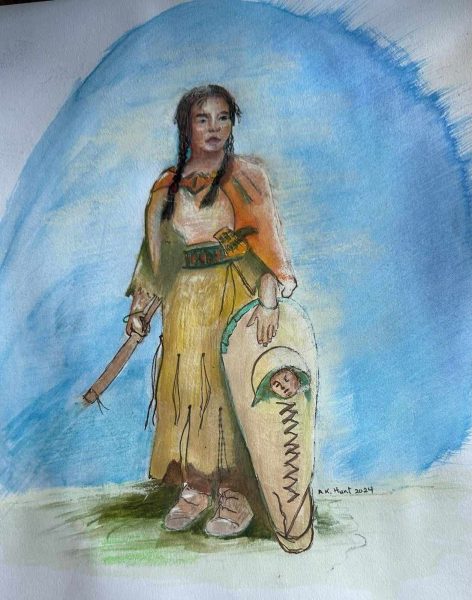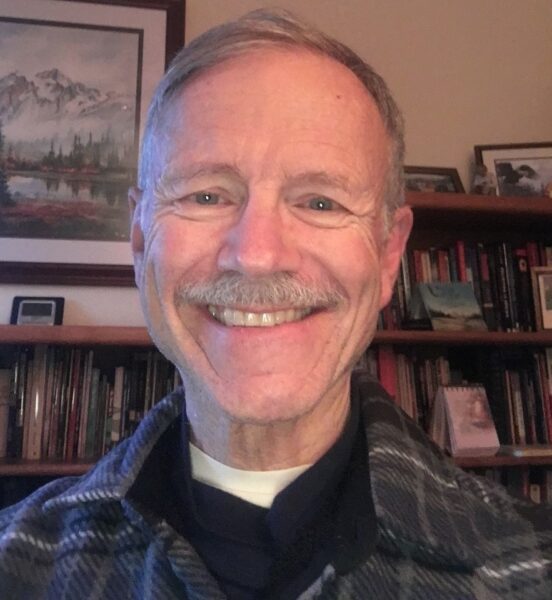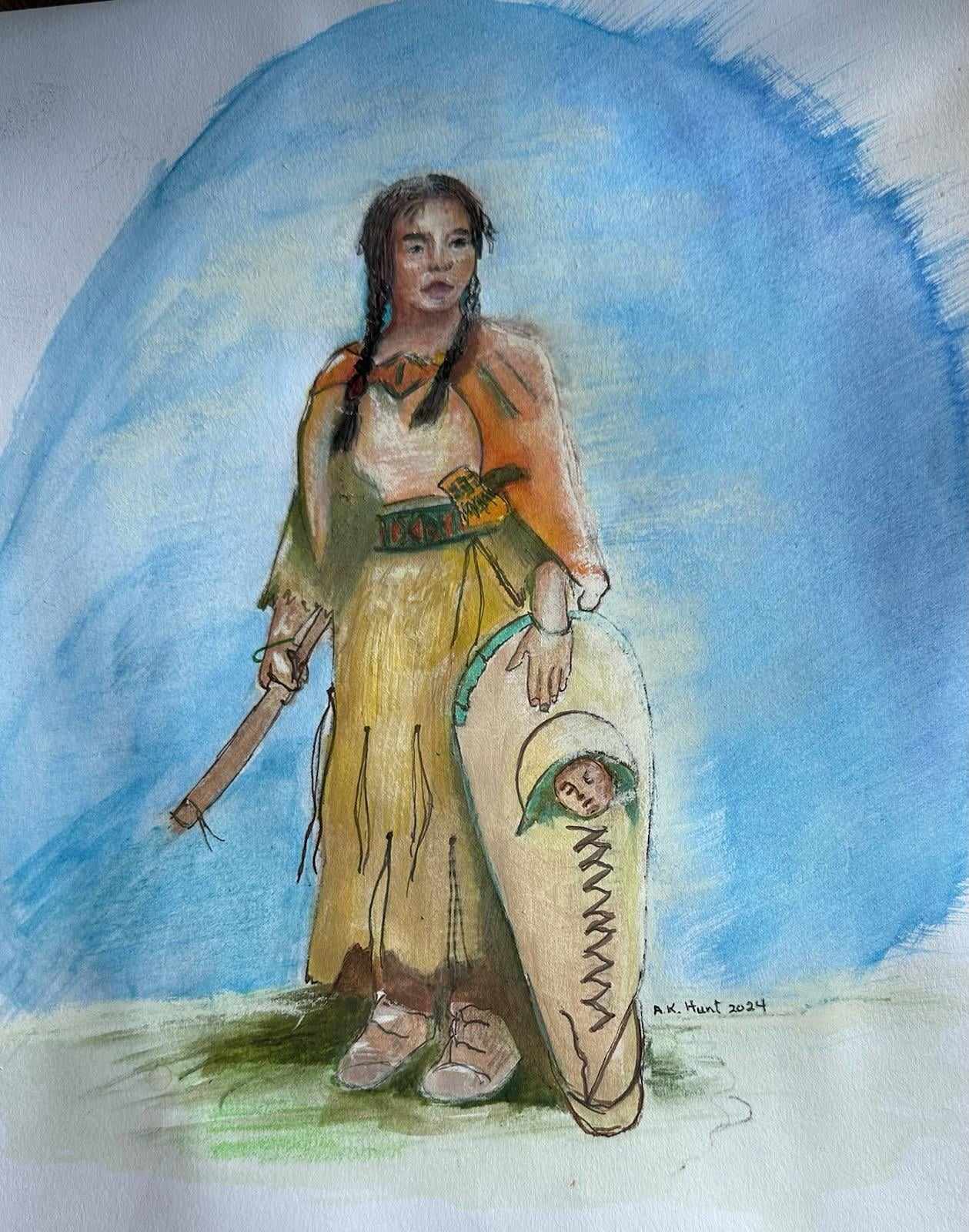2024 marks the 220th anniversary of the Lewis and Clark Voyage of Discovery. This expedition is an essential episode in American history. Moreover, it is vital to the freedom we have to worship God. To focus on Sacagawea helps us see both how the party survived and how God’s greater purpose for America blesses us today.

“Sacagawea and Child” watercolor by Kathy Hunt
On May 14, 1804, under orders from President Thomas Jefferson, their party of some 40 men left St. Louis in three boats bound to explore the North American continent west to the Pacific Ocean. They journeyed upriver by sail and poling on the Missouri about 1000 miles. On October 27 they reached the Mandan villages, with whom they wintered. (The Mandans lived in what is North Dakota today. The Mandans, Minatares, and Shoshones are the three Native American tribes who feature in this saga.)
On February 11, 1805, Lewis wrote their first mention of Sacagawea. She was of the Shoshone tribe who lived west of the Rockies. She had been captured by the Minatares and taken from her homeland five years previously. She then became wife of Charbonneau, a French trapper. The exploring party met them in among the Mandans. She gave birth to her firstborn, a boy that day. Both she and her husband were engaged to serve as interpreters and guides for the expedition.
On April 7, 1805, Lewis wrote that the 32 men in the party set out for the West with “an Indian Woman wife to Charbono with a young child.”1 In April 1805 Sacagawea found artichoke roots and wild currants for the men to eat. The next month one of their boats capsized with her on board. Clark wrote about her: “the Indian woman to whom I ascribe equal fortitude and resolution, with any person onboard at the time of the accident, caught and preserved most of the light articles which were washed overboard.”2 Those articles included their priceless journals! That summer she survived a flash flood by Clark pushing her up out of the ravine while her husband pulled her. She guided them along the Missouri River.
On August 13, 1805, Lewis, leading a small separate group of three men encountered “a party of about 60 warriors mounted on excellent horses who came in nearly full speed.”3 This was the most critical encounter of the entire expedition. Tense negotiations with a peace pipe ensued. Four days later Clark arrived with Sacagawea “who proved to be a sister of Chief Cameahwait. The meeting of those people was really affecting, particularly between Sacagawea and an Indian woman, who had been taken prisoner at the same time with her and who, had afterwards escaped from the Minatares and rejoined her nation.”4
From this point forward Sacagawea was essential to the success not only of the expedition but to the American settlement of the West. The Shoshone, though poor themselves, welcomed and advised them. The party purchased 29 horses from the Shoshone. They proceeded to the Columbia River and down it to the Pacific Coast. There Sacajawea gave up her belt of blue beads to purchase a beautiful robe of sea-otter skins which Lewis wanted to give to President Jefferson. She voted, as did Clark’s black servant York, on where to encamp for the winter. They decided on Clatsop, Oregon, where they built a small fort.
On their return on July 6, 1806, they entered an extensive plain where they lost the Indian trail. Sacagawea informed Clark “that she had been in this plain frequently and knew it well.”5 She guided the party up and through a gap in the Rocky Mountains. A week later Clark wrote: “The indian woman who has been of great service to me as a pilot through this country recommends a gap in the mountain more south which I shall cross.”6 This was Bozeman Pass in Montana.
Though she was offered the opportunity to remain with her Shoshone people, Sacajawea chose to stay with the Lewis and Clark party. She must have realized that she was instrumental in this historic expedition and wanted to see it to its successful conclusion. She with her toddler son continued with them downriver on the Missouri to the Mandan villages.
Following are five conclusions that I draw from Sacajawea’s key role in the Lewis and Clark Voyage of Discovery.
- Sacagawea was instrumental in enabling America to explore and expand and lay claim to North America west of the Rocky Mountains. Most of this land had never been explored by white men. It was disputed by Britain, Spain, and America. When Sacajawea enabled Lewis and Clark to get safely across the western continent and raise the American flag on the Pacific Coast near Astoria, she enabled America to claim this land.
- Sacagawea was key to opening the way the west for America. She guided the explorers across the highest mountains in the mid-continent and showed them the path that paved the way for future emigration to the West.
- Sacagawea was essential to encourage American women that they could survive and settle in the wilderness. She gave proof to women that not only men but also women could thrive in the wild West.
- Having her baby in the wild West and traveling about six thousand miles round trip in the wilderness, Sacagawea showed American women and mothers that they could do so as well.
- Sacagawea was instrumental in bringing freedom of religion to Western America. Britain and Spain both had state-controlled religion. The First Amendment to the U.S. Constitution states that “Congress shall make no law respecting an establishment of religion or prohibiting the free exercise thereof.” By enabling America to claim the vast western lands, Sacagawea enabled missionaries to bring the Gospel of Christ to the Native Americans as well as the settlers who subsequently came west.
In response to a vision, in 1832 four Native Americans from the Nez Perce and Bitterroot Salish (Flathead) tribes were sent to William Clark in St. Louis. Their request was for someone to bring them the “Book of Heaven.” In 1834 Jason Lee went west with the Bible to win Native Americans to Christ. Dr. Marcus Whitman went to minister to those nations in 1835 and returned the following year, married Narcissa, and in 1836 with other missionaries established several missions. This was just the beginning of spread of the Gospel into the West of North America.
Notes
1 Frank Bergon, ed., The Journal of Lewis and Clark (New York, 1989), p. 98. The quotes are in the often incorrect spellings and capitalizations of Lewis and Clark.
2 Ibid., p. 129.
3 Ibid., p. 227.
4 Ibid., p. 239.
5 Ibid., p. 442. “indian” was not capitalized by Clark.
6 Ibid., p. 443.

Tom Giesecke (Sonrise Magazine Editor) Author. Grew up in Olympia, WA, where he received Christ at age 15. He graduated from Davidson College, NC, and Emory University School of Medicine, Atlanta, GA. After his medical internship at the National Naval Medical Center Bethesda, MD, he trained and served as a U.S. Navy Flight Surgeon for four years. Following residency training, he served thousands of people as a Board-certified Family Physician for more than thirty-five years. Learning of God’s love motivates Tom to daily search the Scriptures for more. Tom has led Bible studies for many years and enjoys sharing “the word of God, and recently publishing a book (find in the Sonrise Bookstore and Amazon) on the grace of God: Gracious Goodness.” Reach Tom at tomgiesecke@comcast.net

Leave a Reply